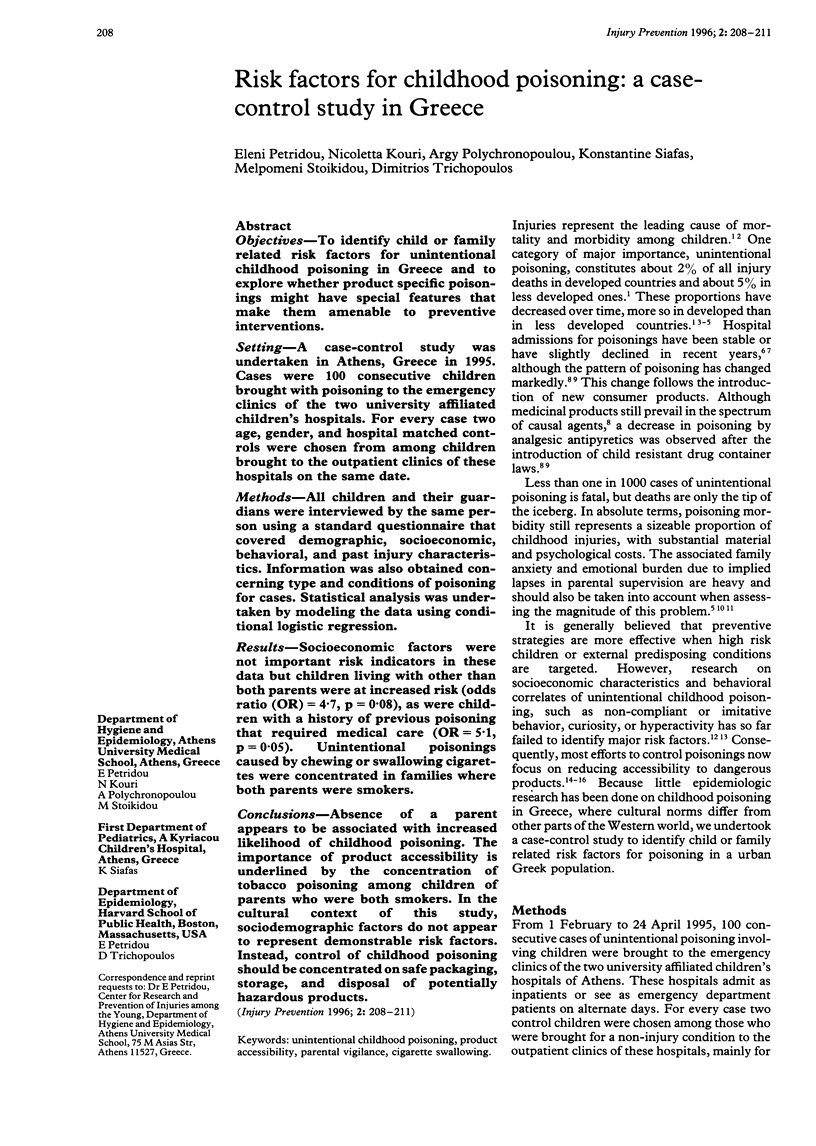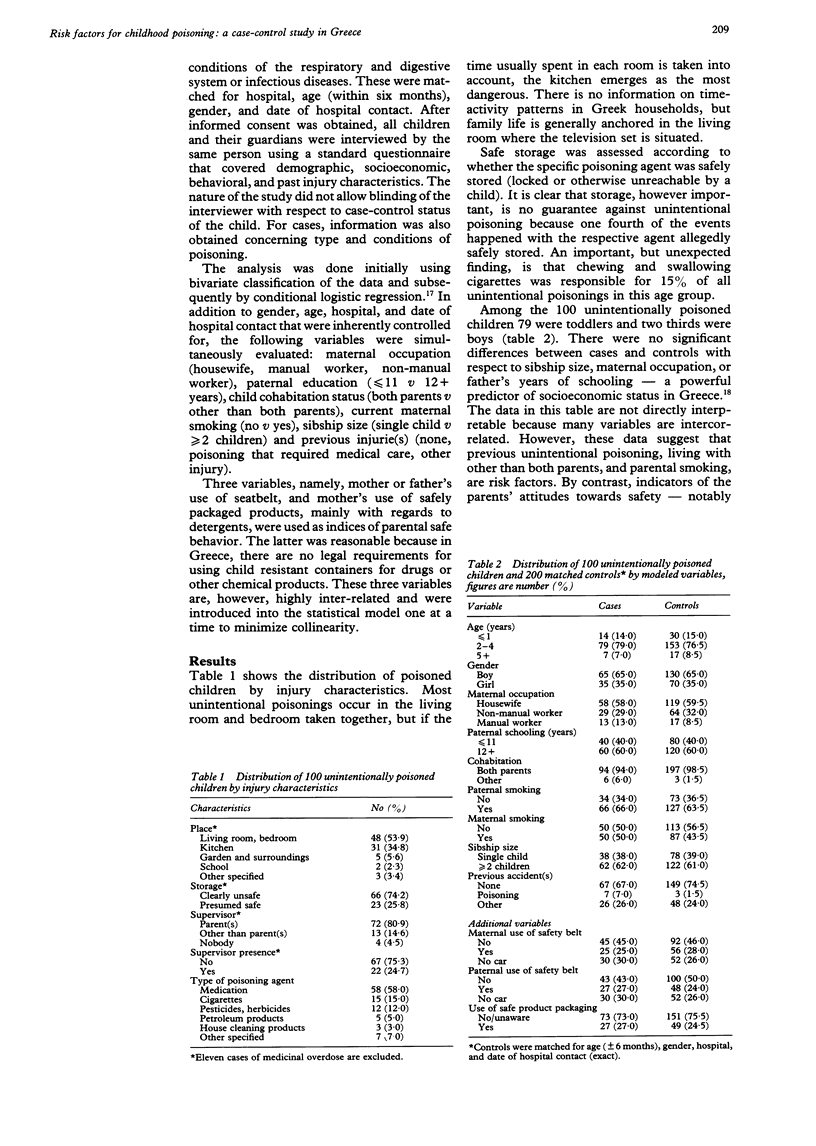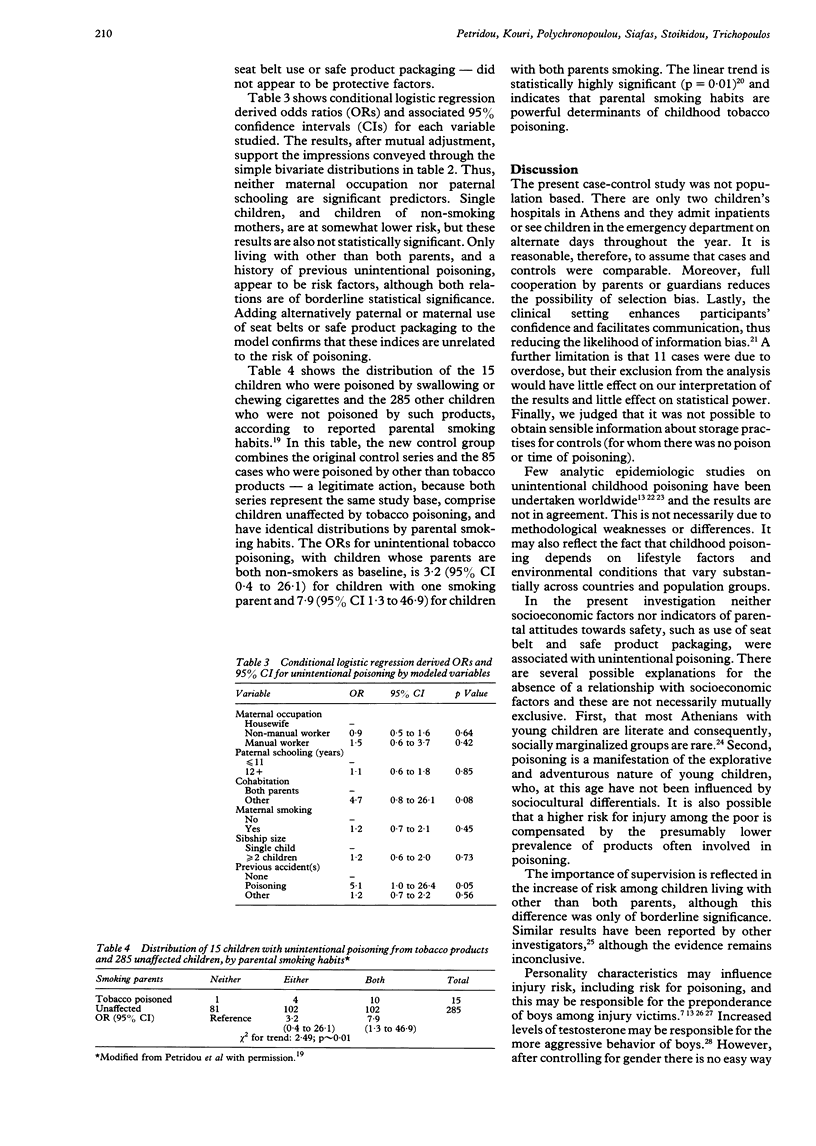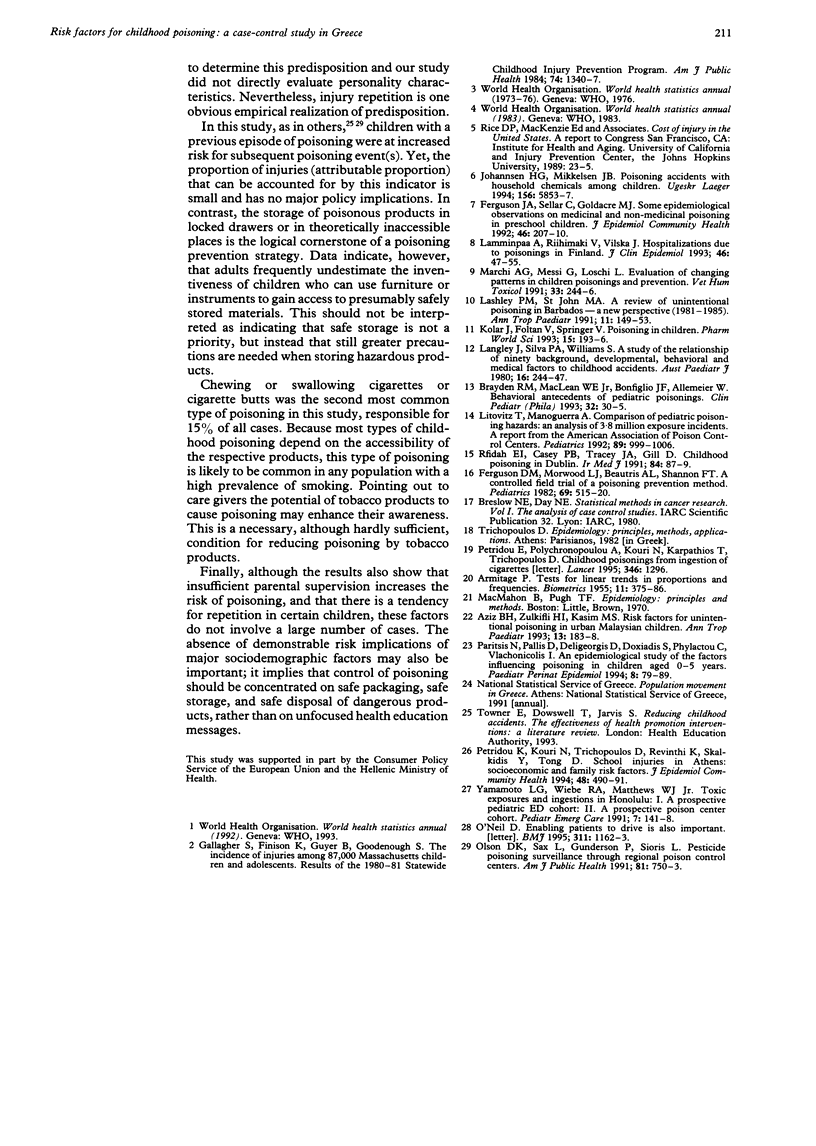Abstract
OBJECTIVES: To identify child or family related risk factors for unintentional childhood poisoning in Greece and to explore whether product specific poisonings might have special features that make them amenable to preventive interventions. SETTING: A case-control study was undertaken in Athens, Greece in 1995. Cases were 100 consecutive children brought with poisoning to the emergency clinics of the two university affiliated children's hospitals. For every case two age, gender, and hospital matched controls were chosen from among children brought to the outpatient clinics of these hospitals on the same date. METHODS: All children and their guardians were interviewed by the same person using a standard questionnaire that covered demographic, socioeconomic, behavioral, and past injury characteristics. Information was also obtained concerning type and conditions of poisoning for cases. Statistical analysis was undertaken by modeling the data using conditional logistic regression. RESULTS: Socioeconomic factors were not important risk indicators in these data but children living with other than both parents were at increased risk (odds ratio (OR) = 4.7, p = 0.08), as were children with a history of previous poisoning that required medical care (OR = 5.1, p = 0.05). Unintentional poisonings caused by chewing or swallowing cigarettes were concentrated in families where both parents were smokers. CONCLUSIONS: Absence of a parent appears to be associated with increased likelihood of childhood poisoning. The importance of product accessibility is underlined by the concentration of tobacco poisoning among children of parents who were both smokers. In the cultural context of this study, sociodemographic factors do not appear to represent demonstrable risk factors. Instead, control of childhood poisoning should be concentrated on safe packaging, storage, and disposal of potentially hazardous products.
Full text
PDF



Selected References
These references are in PubMed. This may not be the complete list of references from this article.
- Azizi B. H., Zulkifli H. I., Kasim M. S. Risk factors for accidental poisoning in urban Malaysian children. Ann Trop Paediatr. 1993;13(2):183–188. doi: 10.1080/02724936.1993.11747643. [DOI] [PubMed] [Google Scholar]
- Brayden R. M., MacLean W. E., Jr, Bonfiglio J. F., Altemeier W. Behavioral antecedents of pediatric poisonings. Clin Pediatr (Phila) 1993 Jan;32(1):30–35. doi: 10.1177/000992289303200106. [DOI] [PubMed] [Google Scholar]
- Ferguson J. A., Sellar C., Goldacre M. J. Some epidemiological observations on medicinal and non-medicinal poisoning in preschool children. J Epidemiol Community Health. 1992 Jun;46(3):207–210. doi: 10.1136/jech.46.3.207. [DOI] [PMC free article] [PubMed] [Google Scholar]
- Fergusson D. M., Horwood L. J., Beautrais A. L., Shannon F. T. A controlled field trial of a poisoning prevention method. Pediatrics. 1982 May;69(5):515–520. [PubMed] [Google Scholar]
- Gallagher S. S., Finison K., Guyer B., Goodenough S. The incidence of injuries among 87,000 Massachusetts children and adolescents: results of the 1980-81 Statewide Childhood Injury Prevention Program Surveillance System. Am J Public Health. 1984 Dec;74(12):1340–1347. doi: 10.2105/ajph.74.12.1340. [DOI] [PMC free article] [PubMed] [Google Scholar]
- Johannsen H. G., Mikkelsen J. B. Forgiftningsulykker med husholdningskemikalier blandt børn. Ugeskr Laeger. 1994 Oct 3;156(40):5853–5857. [PubMed] [Google Scholar]
- Kolár J., Foltán V., Springer V. Poisoning in children. Pharm World Sci. 1993 Oct 15;15(5):193–196. doi: 10.1007/BF01880625. [DOI] [PubMed] [Google Scholar]
- Lamminpä A., Riihimäki V., Vilska J. Hospitalizations due to poisonings in Finland. J Clin Epidemiol. 1993 Jan;46(1):47–55. doi: 10.1016/0895-4356(93)90008-o. [DOI] [PubMed] [Google Scholar]
- Langley J., Silva P. A., Williams S. A study of the relationship of ninety background, developmental, behavioural and medical factors to child hood accidents. A report from the Dunedin Multidisciplinary Child Development Study. Aust Paediatr J. 1980 Dec;16(4):244–247. [PubMed] [Google Scholar]
- Lashley P. M., St John M. A. A review of accidental poisoning in Barbados--a new perspective (1981-1985). Ann Trop Paediatr. 1991;11(2):149–153. doi: 10.1080/02724936.1991.11747494. [DOI] [PubMed] [Google Scholar]
- Litovitz T., Manoguerra A. Comparison of pediatric poisoning hazards: an analysis of 3.8 million exposure incidents. A report from the American Association of Poison Control Centers. Pediatrics. 1992 Jun;89(6 Pt 1):999–1006. [PubMed] [Google Scholar]
- Marchi A. G., Messi G., Loschi L. Evaluation of changing patterns in children poisonings and prevention. Vet Hum Toxicol. 1991 Jun;33(3):244–246. [PubMed] [Google Scholar]
- Olson D. K., Sax L., Gunderson P., Sioris L. Pesticide poisoning surveillance through regional poison control centers. Am J Public Health. 1991 Jun;81(6):750–753. doi: 10.2105/ajph.81.6.750. [DOI] [PMC free article] [PubMed] [Google Scholar]
- Paritsis N., Pallis D., Deligeorgis D., Doxiadis S., Phylactou C., Vlachonicolis I. An epidemiological study of the factors influencing poisoning in children aged 0-5 years. Paediatr Perinat Epidemiol. 1994 Jan;8(1):79–89. doi: 10.1111/j.1365-3016.1994.tb00437.x. [DOI] [PubMed] [Google Scholar]
- Petridou E., Kouri N., Trichopoulos D., Revinthi K., Skalkidis Y., Tong D. School injuries in Athens: socioeconomic and family risk factors. J Epidemiol Community Health. 1994 Oct;48(5):490–491. doi: 10.1136/jech.48.5.490. [DOI] [PMC free article] [PubMed] [Google Scholar]
- Petridou E., Polychronopoulou A., Kouri N., Karpathios T., Trichopoulos D. Childhood poisonings from ingestion of cigarettes. Lancet. 1995 Nov 11;346(8985):1296–1296. doi: 10.1016/s0140-6736(95)91896-5. [DOI] [PubMed] [Google Scholar]
- Rfidah E. I., Casey P. B., Tracey J. A., Gill D. Childhood poisoning in Dublin. Ir Med J. 1991 Oct;84(3):87–89. [PubMed] [Google Scholar]
- Yamamoto L. G., Wiebe R. A., Matthews W. J., Jr Toxic exposures and ingestions in Honolulu: I. A prospective pediatric ED cohort; II. A prospective poison center cohort. Pediatr Emerg Care. 1991 Jun;7(3):141–148. doi: 10.1097/00006565-199106000-00003. [DOI] [PubMed] [Google Scholar]


